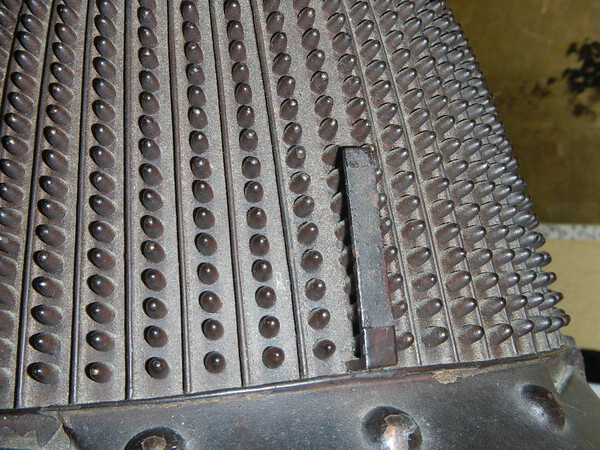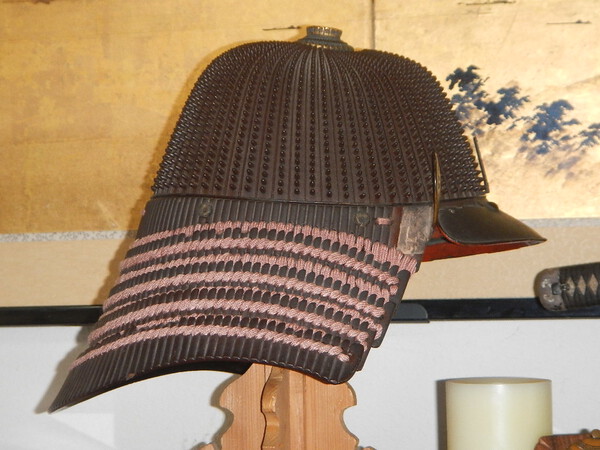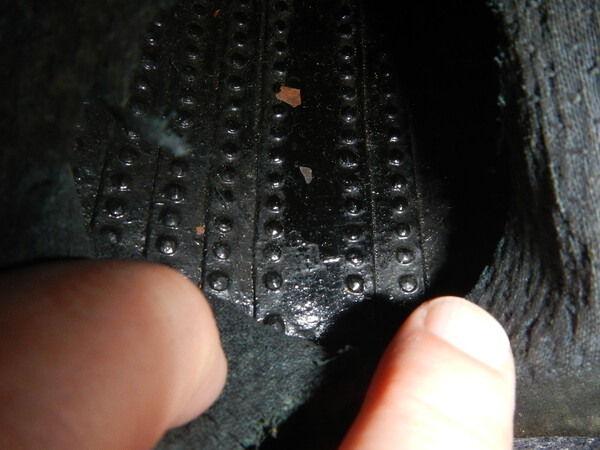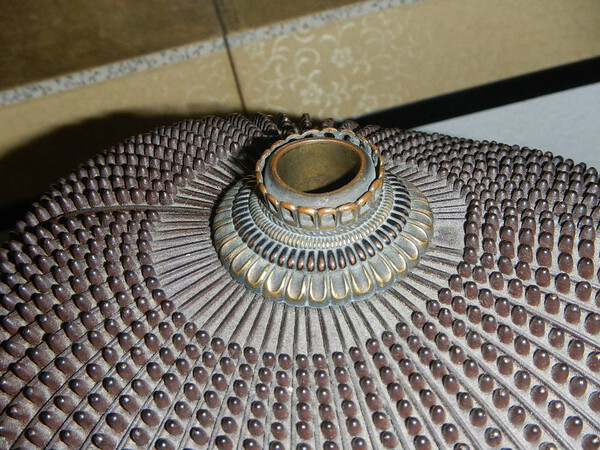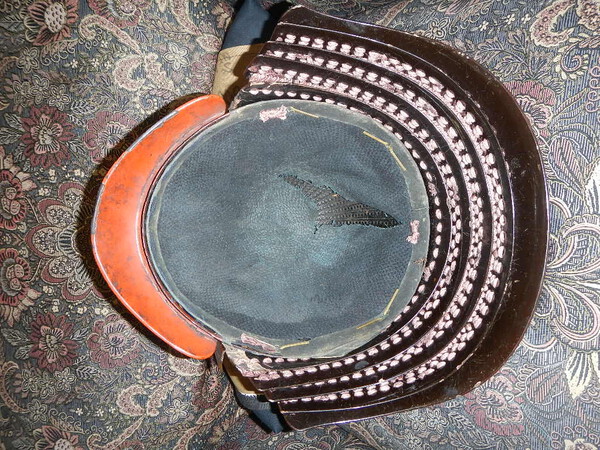-
Posts
25 -
Joined
-
Last visited
Everything posted by Shimazu
-
Curran, Morita-san, John, and George, Thanks again for your input, research and comments. They are much appreciated. John, yes, the translation was on the site (in Romanji), but I could not verify the translation myself, and needed help. I have gone down the wrong path before. I did not want to mention the website's translation, fearing it might sway opinion. I apologize if this caused any problems. Your research is excellent, and the information you provided was very helpful.
-
Thank you very much!
-
-
Hi Curran, I'm not sure of anything except the ichi. :?
-
Hi All, Can anybody translate this? It is beyond my abilities to read, but here is a stab at it: 一東子 ?翁 Thanks,
-
Thanks Curran, I was not aware of this. I sure hope your tsuba passed shinsa!
-
Henry, I agree with your groupings of 1, 3, 5, 6, 7, 8 and 2, 4, 9, 10, but to my eye the variation within the two groups is just too great for me to accept just two ‘signers’. Just my opinion, nothing more.
-
Could you provide more details on this? Thanks,
-
Just my opinion, and sacrilege I know, but I see more than two ‘hands’ here.
-
Piers, Thank you for the references, diagrams and info. I don’t have the books you mention, and appreciate you posting the diagrams. I am able to translate the labels on the diagrams, so at least for me, you don’t need to bother translating them. Your comment that older abumi are generally longer than newer abumi is very interesting and valuable information, something I will eagerly investigate. The lacquered Kura and Abumi you posted are beautiful, and bring up another question I have had for a long time. Every pair of lacquered abumi I have ever seen has a “three diamond” pattern just under the ‘buckle’ on the side facing away from the horse. I have never seen this mark on the matching saddle. Does anybody know the significance of this design on lacquered abumi? Thanks,
-
Wow, thank you Piers! I have been collecting abumi for years, and, so far, I only have one book that covers abumi (Kaga Han no Wasa to dezein KATCHU – ABUMI - TOSOGU). It is in Japanese with many photos, but, other than names, dates and terms, the majority of the text is completely lost to me, as I do not speak Japanese. I have almost given up learning much more about Abumi. I truly appreciate you showing these abumi to a Japanese expert. I will watch this thread for anything you are able to relay back to me/us. Thanks again,
-
I have been frustrated by this for years. I use Acrobat Pro on a Win 7 computer, and you CAN search by kanji in several of the Haynes pdf files, generally the ones in the first third of the alphabet (I can list them If anybody wants). It would seem that some of the files were saved in a pdf format that included the kanji, in font form, but the majority were not. Also, if you want to search for words that include a macron (long vowel mark), you need to cut and paste the character from the pdf into the search box, at least I haven’t found another way to do this on a Windows machine. It would be fantastic to be able to search the entire “Haynes Index” by kanji. Perhaps someone who knows Bob well could discuss this with him to see if there is any possibility that the publisher might be willing to create a ‘kanji searchable’ set of files. I did talk to Bob about this several years ago, but I am not sure I was able to clearly explain the problem to him. I don’t believe that he is a computer user.
-
Jean, I wish I could remember that when I am tempted by a new goody! :D John, Thanks, but even with your help this is eluding me. :?
-
John, I totally agree! My question is concerning the Haynes citation (H 08003.0) which seems to use a different kanji, hence my question to Markus. Same guy? I don't know.
-
Markus, do you have a Haynes number for this Saneyuki? The one I find is, I believe, a different kanji, 真 (not 實 or 実)??
-
I am certainly not an expert, but I would not be too quick to call the mei on the kozuka gimei. The work is good, and there are mei and kaō in Wakayama's 3 volume set that are very close to this one. I would also want to know the signature on the rest of the fittings, unfortunately, I haven’t been able to figure them out yet.
-
I see 實幸, not sure of the reading, possibly Jitsukō.
-

WWII era Samuria Military Sword Help
Shimazu replied to texasnorton's topic in Translation Assistance
Regarding the jū kanji; On page 40 of John Slough’s book “An Oshigata Book of Modern Japanese Swordsmiths 1868-1945” he shows an oshigata that has a Jū kanji virtually identical to this nakago. Also on page 40 is an oshigata translated as Seki jū Mori Kaneharu. While the kanji does not look like a typical jū kanji, it would appear that a translation of this nakago could well be Seki jū Mori Toshiharu Saku as David has suggested. -
Oops, Brian, not Brien. Sorry
-
Hi Brien, Thank you, I am happy you like the two items I have posted questions about. When I stumbled on the thread “Kabuto any thoughts” in the Katchu section, discussing kabuto looking very similar to my only helmet, I decided it was time to join this excellent board, get brave, and ask some questions. Though I collect abumi, this pair being my favorite, I have virtually no information on them. For years I have been wondering why these had a “signature” on the front, and just what it meant. I have been a longtime reader of NMB, and have been quite impressed by the level of discussion in all of the various sections I have looked at. I have also been impressed with the smoothness with which this board generally runs. Hopefully I will be able to contribute something to this forum in the future, and not just ask questions.
-
John, I like the Shigetaka reading better (if it's even a name). I don't know why I chose Keiken. As you said, there are many possibilities. Thanks,
-
Thanks Piers, that would be much appreciated! Jack E
-
Hello, I hope a question about abumi is appropriate for the NMB. Unlike any other abumi I have, these have kanji located prominently on their front face. My reading is 中村恵賢, with the last kanji being in doubt. It is not quite the same as on the abumi, the upper left element appearing different, but I can’t find anything closer. Assuming I have the last kanji is correct, a possible reading of these kanji is Nakamura Keiken. My questions are: * What is the correct last kanji? * Is this a signature, or something else? It seems to be in a very prominent position for a signature, especially on a piece that was owned by somebody that could afford these. I have been unable to locate any artist or place using these kanji. Thanks, Jack E
-
John, Ian and Luc, Thank you very much for the information and encouragement! Your knowledge is impressive and your comments are greatly appreciated. I suppose I will keep my eyes open for other pieces, but other than a collection of abumi, this is my only piece of armour.
-
Hi All, I have an unsigned koboshi kabuto that to my eye looks similar to several posted in this thread though clearly not as nice as those shown. Did Nagamichi or other known armor makers ever produce unsigned pieces, or are unsigned kabuto usually/always considered school or student pieces? I am a complete novice when it comes to Katchu so please be gentle. There are 31 koboshi per row. I just joined the NMB a week or so ago, and hope it is not considered bad form to join this topic so late. Thanks, Jack E







